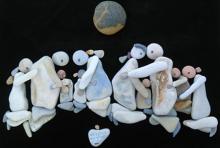Submitted by ARASAllison on
 ‘Art does not reproduce what we see, rather it makes us see’, Paul Klee.
‘Art does not reproduce what we see, rather it makes us see’, Paul Klee.
The images which you will find here are creative responses by Syrian refugees and artists to the almost unimaginable plight of the many thousands of refugees displaced by the Syrian war. They are gestures made into the empty spaces of destroyed homes, communities and cities, temporary refugee camps and makeshift roadside dwellings, overcrowded buses and boats adrift on endless roads and inhospitable seas. They speak of the empty eyes of mothers and fathers who have lost loved children, wives and husbands and, for the time being, any sense of safety, purpose and future.
These images are a testament to both the inhumanity of war and the courage of the human spirit and all give voice to an experience and grief which is beyond words. Figures 2, 3, 4 and 11, 13 and 14 are examples of the work made by refugees who have found some sanctuary in the various camps in the Middle East (the names of the artists have been withheld by the UNHCR).
Before we can find words, it helps to find an image--or to make one--that can hold the experience for us until it becomes safe enough to feel the emotions associated with it. Only when we are safe enough to feel, are wel able to think about what has happened and find a place for it in mind and memory. In the finding and creating of images an oppurtunity arises that can potentially transform an empty inhumane space into an imaginative human place in which feeling and hope of recovery might be found again, even if momentarily. Relief in such circumstances may be fleeting but a thread, however flimsy, can help humans continue to put one foot in front of the other.